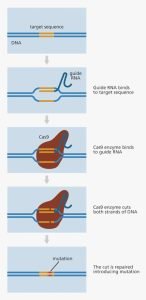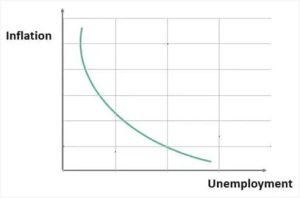CRISPR-Cas9
- CRISPR-Cas9 is a unique technology that enables geneticists and medical researchers to edit parts of the genome by removing, adding or altering sections of the DNA sequence.
- Genome: An organism’s complete set of genetic instructions. Each genome contains all of the information needed to build that organism and allow it to grow and develop.
- DNA: A long molecule that contains our unique genetic code. It holds the instructions for making all the proteins in our bodies.
- It is currently the simplest, most versatile and precise method of genetic manipulation and is therefore causing a buzz in the science world.
How does it work?
- The CRISPR-Cas9 system consists of two key molecules that introduce a change (mutation) into the DNA. These are:
- An enzyme called Cas9. This acts as a pair of ‘molecular scissors’ that can cut the two strands of DNA at a specific location in the genome so that bits of DNA can then be added or removed.
- An enzyme is a biological molecules, usually proteins that are responsible for thousands of metabolic processes essential to life.
- A piece of RNA called guide RNA (gRNA). This consists of a small piece of pre-designed RNA sequence (about 20 bases long) located within a longer RNA scaffold. The scaffold part binds to DNA and the pre-designed sequence ‘guides’ Cas9 to the right part of the genome. This makes sure that the Cas9 enzyme cuts at the right point in the genome.
- RNA is a nucleic acid similar in structure and properties to DNA, but it only has a single strand of bases and instead of the base thymine (T), RNA has a base called uracil (U).
- The guide RNA is designed to find and bind to a specific sequence in the DNA. The guide RNA has RNA bases that are complementary to those of the target DNA sequence in the genome. This means that, at least in theory, the guide RNA will only bind to the target sequence and no other regions of the genome.
- The Cas9 follows the guide RNA to the same location in the DNA sequence and makes a cut across both strands of the DNA.
- At this stage the cell recognises that the DNA is damaged and tries to repair it.
- Scientists can use the DNA repair machinery to introduce changes to one or more genes? in the genome of a cell of interest.

Phillips curve
- Phillips curve postulates an inverse relationship between inflation and unemployment.
- Stagflation is an economic cycle characterized by slow growth and a high unemployment rate accompanied by inflation. Economic policymakers find this combination particularly difficult to handle, as attempting to correct one of the factors can exacerbate another.
- Once thought by economists to be impossible, stagflation has occurred repeatedly in the developed world since the 1970s oil crisis. Stagflation is measured by misery index.

Four New Countries Consulted to Join OPEC
- Recently, the Organization of the Petroleum Exporting Countries (OPEC) Secretary General announced that discussions are underway with four new countries, namely Azerbaijan, Malaysia, Brunei, and Mexico, to join the organization.
- OPEC, which was established in 1960 with founding members Iran, Iraq, Kuwait, Saudi Arabia, and Venezuela, now consists of 13 member states. OPEC produces around 30% of the world’s crude oil, with its members accounting for approximately 60% of the global petroleum trade. In 2016, OPEC expanded its alliance by including 10 major oil-producing countries, forming OPEC+.
- OPEC+ includes the 13 OPEC member countries along with Azerbaijan, Bahrain, Brunei, Kazakhstan, Malaysia, Mexico, Oman, Russia, South Sudan, and Sudan. The objective is to coordinate and unify petroleum policies, stabilize oil markets, ensure a steady supply of petroleum to consumers, provide a reliable income for producers, and deliver a fair return on investment in the petroleum industry. The headquarters of OPEC is in Vienna, Austria.
